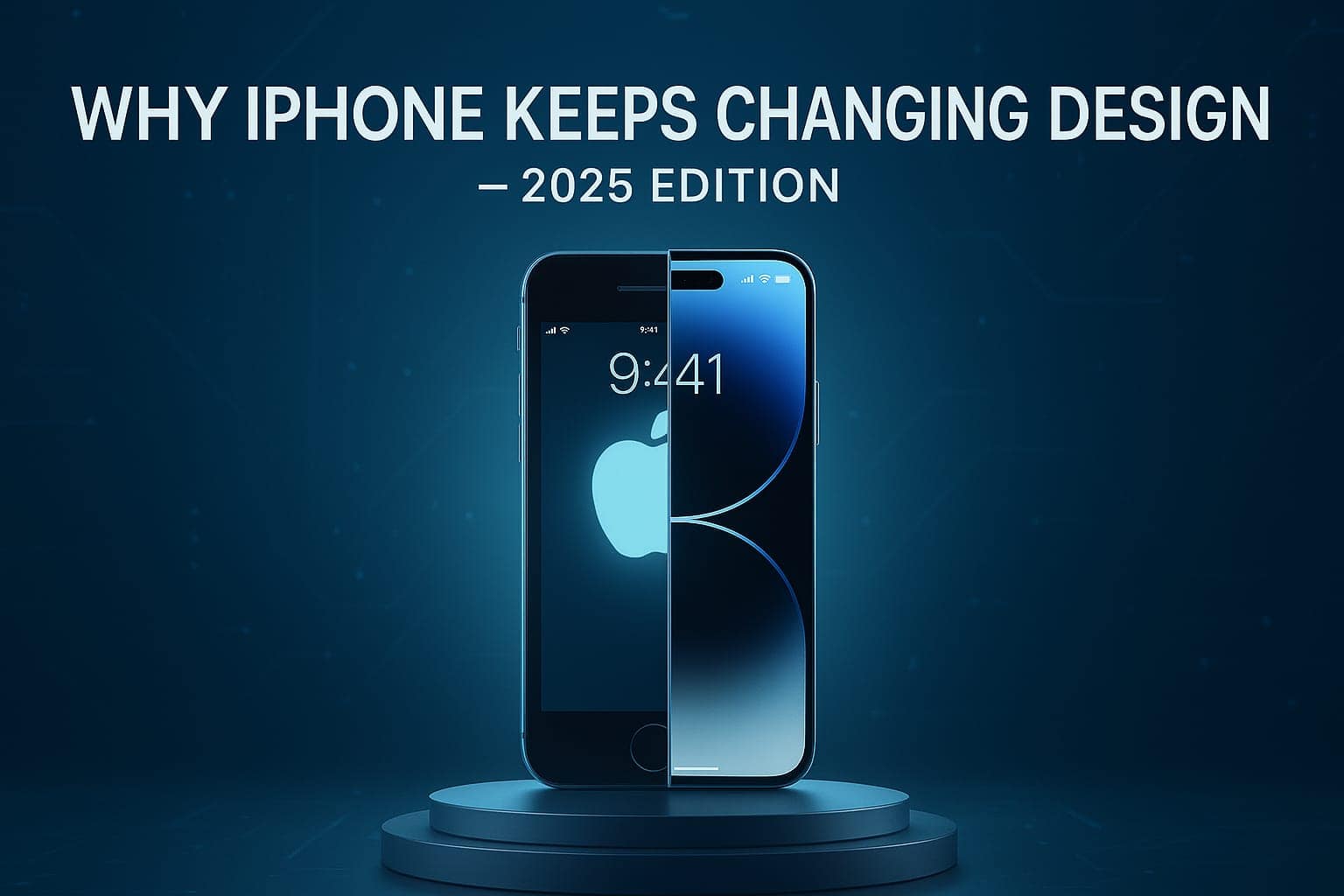Discover Why Apple Keeps Changing the iPhone Design – Explained (2025 Edition) . Explore the hidden reasons behind iPhone design changes and how it impacts users, competition, and tech trends.
Introduction
Ever wondered why Apple changes the iPhone’s design every few years? From the sleek edges of the iPhone 4 to the dynamic island of iPhone 15 and the rumored iPhone 17 foldable twist — Apple doesn’t just change design for fun. There’s a strategy behind it. In this blog, we’ll break it down in a way even your dad or little brother could understand. Let’s explore how Apple uses design changes to stay ahead, capture attention, and dominate the tech world — all while keeping you coming back for more.
1. It’s Not Just Design – It’s Strategy
Apple doesn’t randomly change the iPhone’s look. Every redesign is carefully planned to:
- Keep the brand feeling new and fresh
- Push the industry into the next era
- Justify higher prices
- Encourage users to upgrade
Take the iPhone X. Removing the home button wasn’t just bold — it reset how we interact with phones.
2. User Psychology: New Look = New Value
Whether it’s a flat-edge design or a new camera layout, change creates desire. A new look makes people feel like they’re getting more value. Even if the internals don’t change much, people associate a new design with innovation.
Apple knows this psychology well. That’s why each major upgrade brings a noticeable difference.
3. Competitive Pressure and Market Trends
Samsung, Google Pixel, and even Xiaomi push forward aggressively. To stay competitive in markets like the US and UK, Apple has to keep iPhone designs fresh.
In 2025, foldable screens, under-display cameras, and AI-focused hardware are rising. Apple’s rumored foldable iPhone 17 could be a response to this pressure.
4. Future-Proofing for New Features
Design changes are often necessary for hardware upgrades:
- Bigger batteries need more space
- Advanced cameras require new layouts
- Thermal systems need better airflow
- AI chips and neural engines need optimized structures
In short: new tech demands new space, and new space needs new design.
5. Sustainability and Materials
Apple is shifting toward recycled materials and eco-friendly production. Every design update since iPhone 12 reflects this. Lighter builds, stronger metals, and energy-efficient displays are all part of their long-term green mission.
Design changes help Apple reduce carbon footprint — a huge win for both branding and the planet.
6. Longevity and Repairability
Apple has been quietly improving how repairable iPhones are. Internal design changes allow easier battery or screen replacements. Newer layouts help comply with the “Right to Repair” laws in the US and Europe.
So sometimes, changes that seem purely cosmetic actually support durability and ease of repair.
7. Creating Buzz – It’s Marketing Gold
Design leaks. Render rumors. Twitter trends. iPhone design changes make waves months before launch. That buzz fuels free marketing — keeping Apple top of mind, even for those not planning to upgrade.
8. iOS and Design Harmony
Design isn’t just hardware — it’s how it feels. Apple syncs iOS updates with hardware changes. For example:
- Face ID + swipe gestures = iPhone X
- Dynamic Island = pill-shaped cutout
- Vision Pro = gesture-based ecosystem
This synergy is Apple’s core strength.
9. Future of iPhone Design (2025–2030)
Here’s what we’re hearing:
| Rumored Feature | Likely Design Change |
|---|---|
| Foldable screen | Flexible outer shell |
| Under-display camera | No front cutout |
| No ports (portless) | Magnetic back-only charging |
| AI-enhanced interaction | Additional sensor spaces |
These changes won’t just be about looks — they’ll redefine how we use phones.
10. Apple’s Ecosystem Strategy
Each design change also aligns iPhone with the larger Apple ecosystem:
- Apple Watch bands influence color finishes
- iPads mirror iPhone curves
- AirPods cases blend with iPhone styles
It’s not random. It’s ecosystem-driven design thinking.
Conclusion: Not Just a Pretty Face
Apple’s iPhone design changes aren’t cosmetic—they’re calculated. They serve tech, psychology, business, sustainability, and user needs. And while they spark criticism, they also drive the iPhone’s continued dominance.
So the next time you wonder “Why’d they move the camera again?” — know that it’s likely a move backed by deep strategy, not just style.
FAQs: Why iPhone Design Keeps Changing
Q1. Does changing iPhone design help Apple sell more?
Yes. A new design generates excitement and encourages more people to upgrade, especially those who skip yearly releases.
Q2. Are design changes just marketing gimmicks?
No. Most changes support new technology, improve durability, and align with user experience needs.
Q3. Will iPhone go completely portless?
Likely yes — Apple is already moving toward MagSafe and wireless solutions.
Q4. Why does Apple redesign even small things?
Small tweaks improve efficiency, reduce manufacturing costs, or support upcoming features.
Q5. Which iPhone design has been most revolutionary?
The iPhone X (2017) marked a major shift — it removed the home button, added Face ID, and changed interaction forever.
